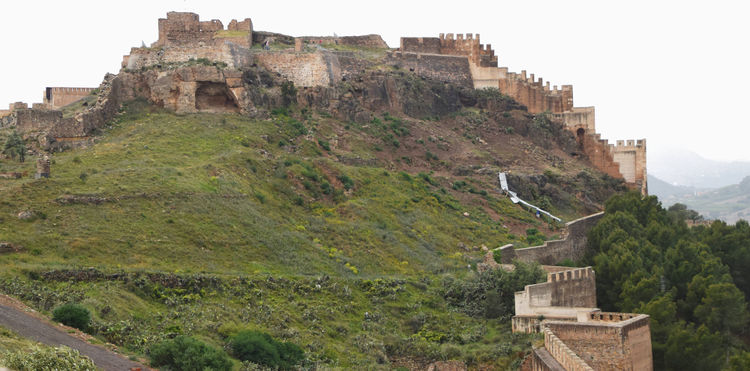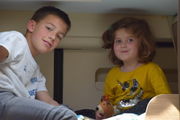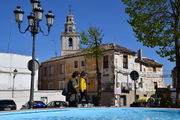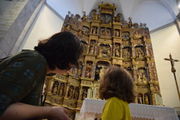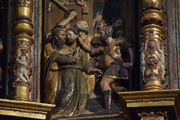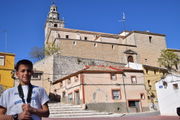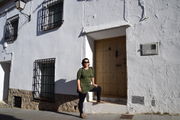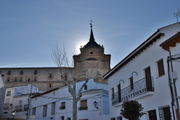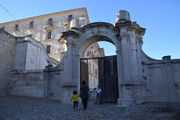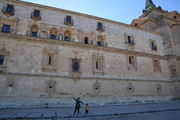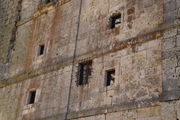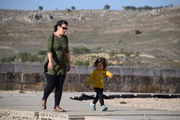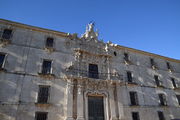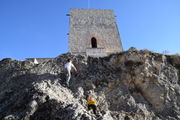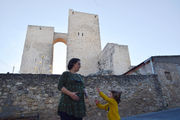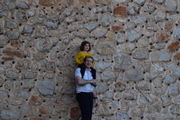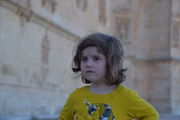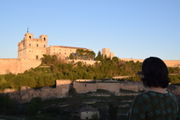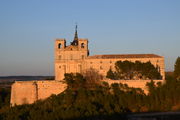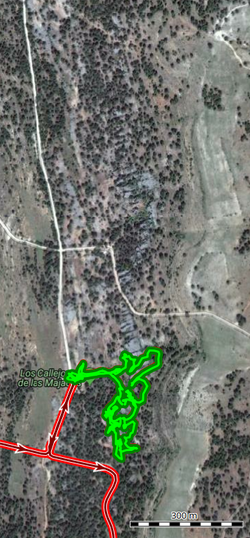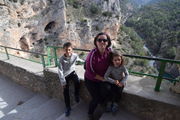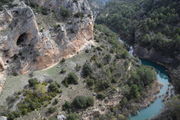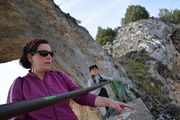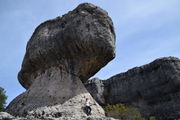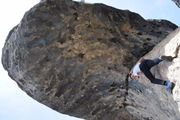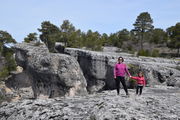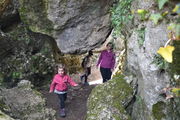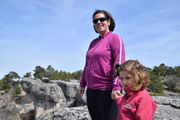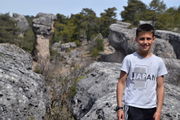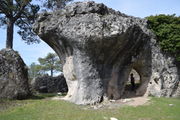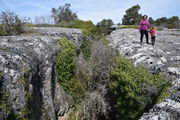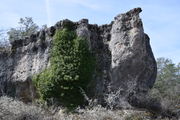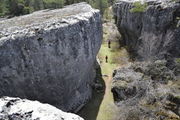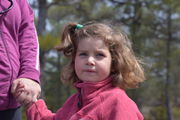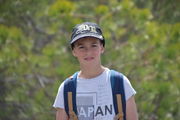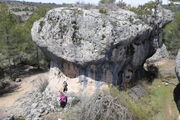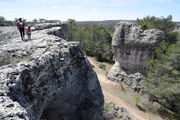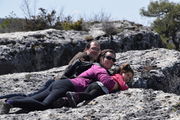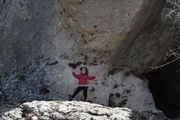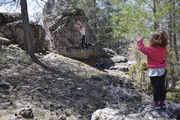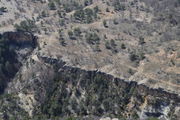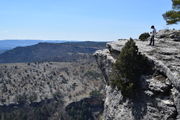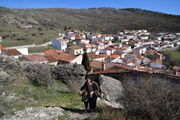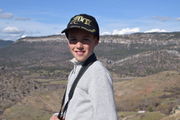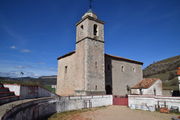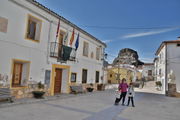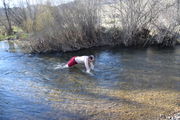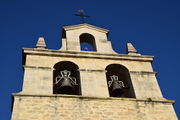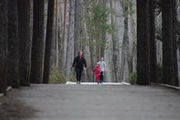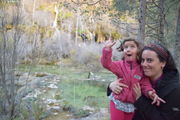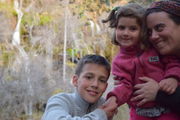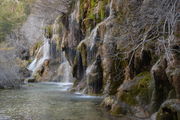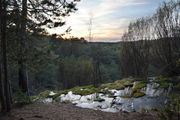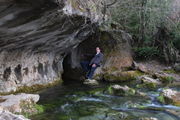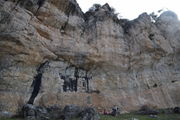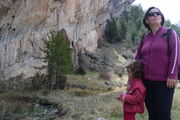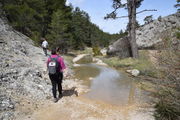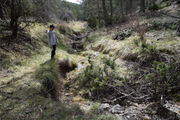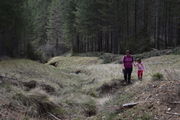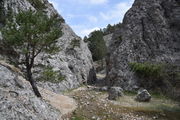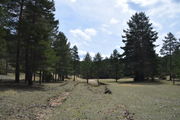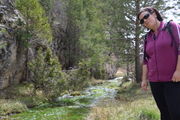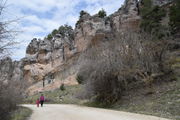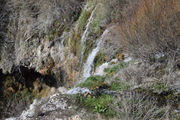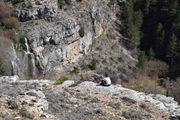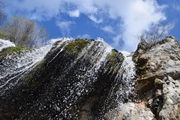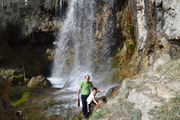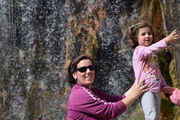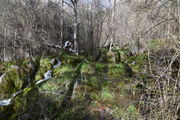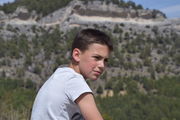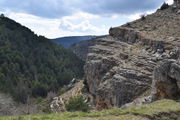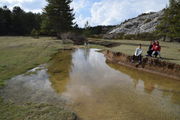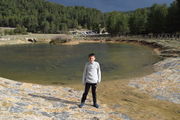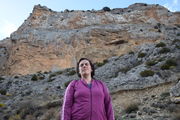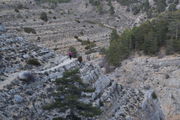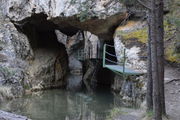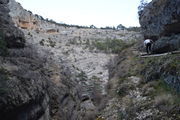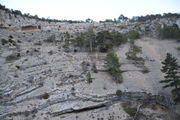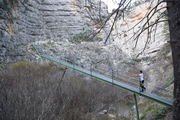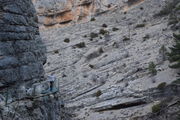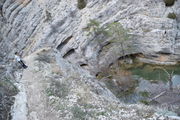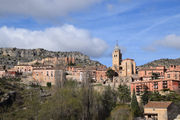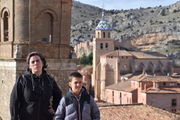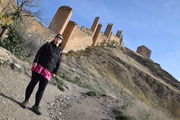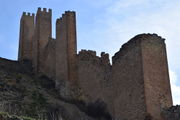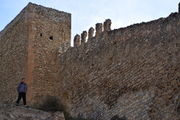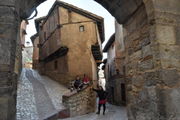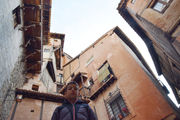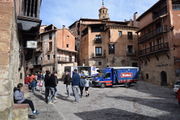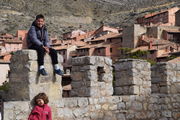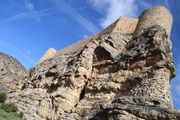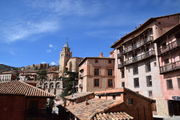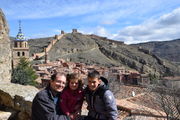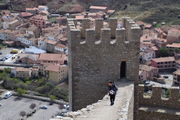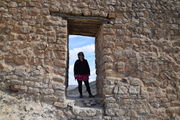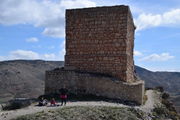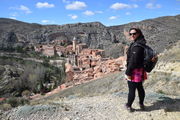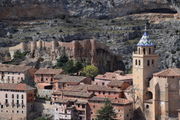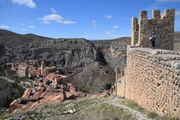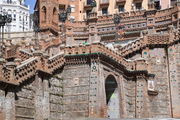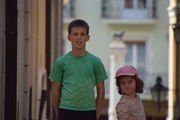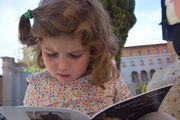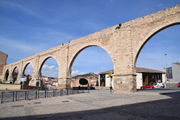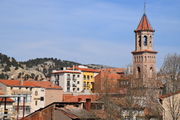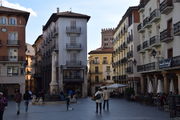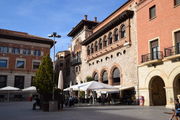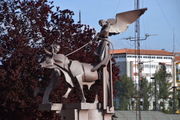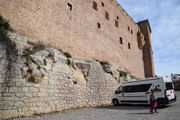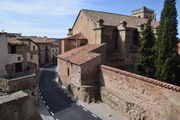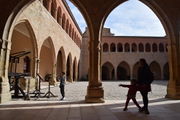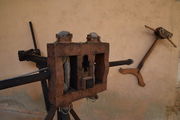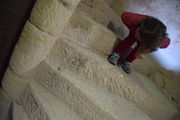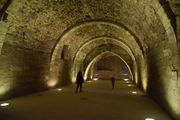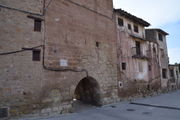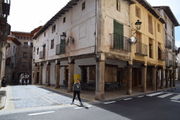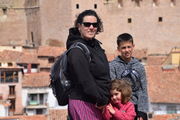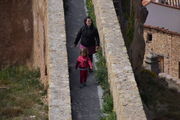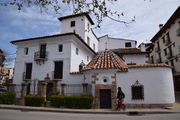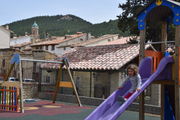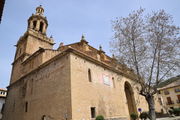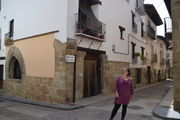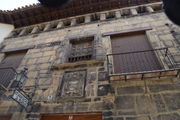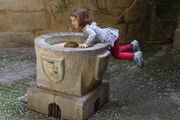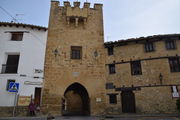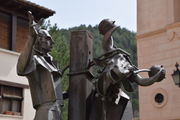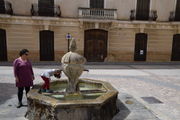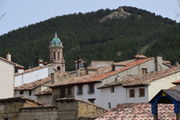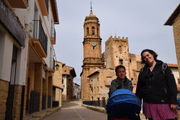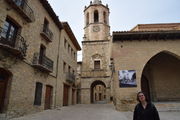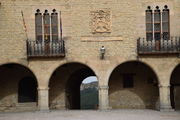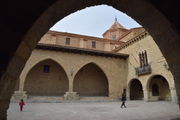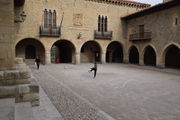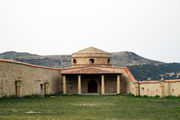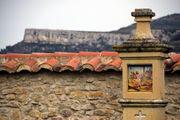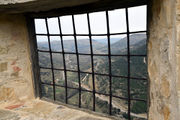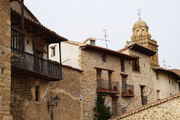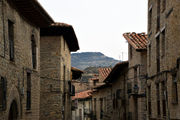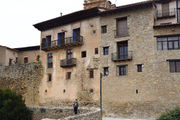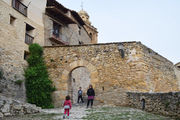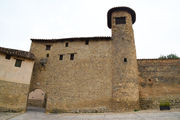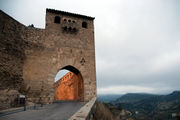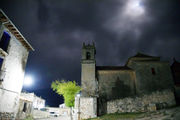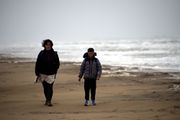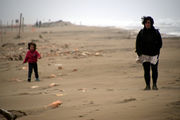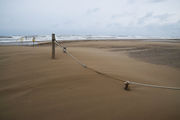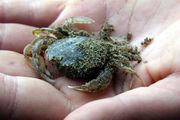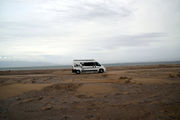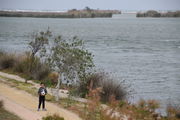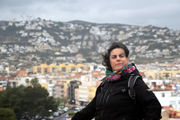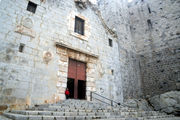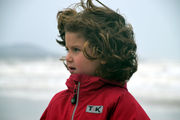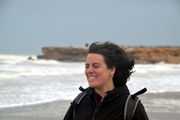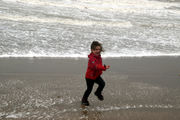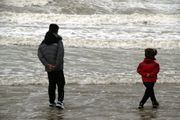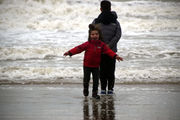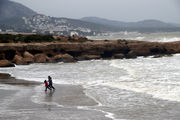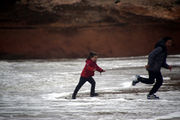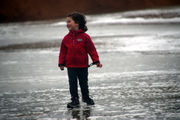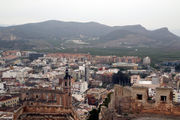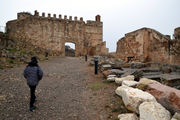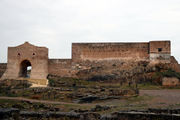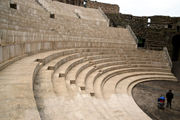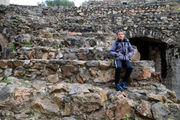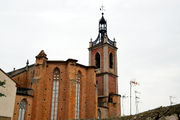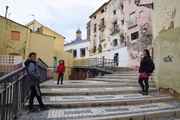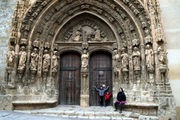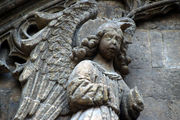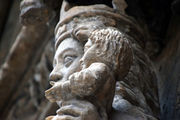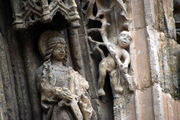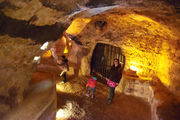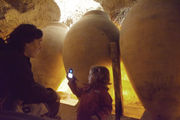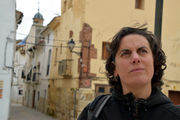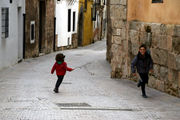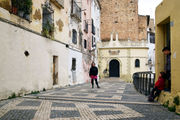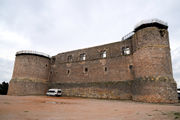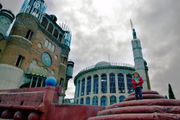m (→Cascada del Molino de la Chorrera) |
m (→Ventano del Diablo, Callejones de Las Majadas, Mirador del Tío Cogote) |
||
| (30 intermediate revisions by one user not shown) | |||
| Line 1: | Line 1: | ||
| − | = <span style="position:relative;top:-5px;background-color: rgba(60, 59, 59, .5); color: white;z-index:20;"> | + | = <span style="position:relative;top:-5px;background-color: rgba(60, 59, 59, .5); color: white;z-index:20;">Easter trip (with Antoine) to Eastern Spain (April 2019)</span> = |
<wz tip="Antoine in the Serranía de Cuenca, contemplating the Cascada del Molino from one of our three vantage points."><poem> | <wz tip="Antoine in the Serranía de Cuenca, contemplating the Cascada del Molino from one of our three vantage points."><poem> | ||
| Line 13: | Line 13: | ||
On {{thisday|13|April|2019}}. | On {{thisday|13|April|2019}}. | ||
| − | We took the van at 10h30. We spent 1h30 in a nearby supermarket (Rivas-Vaciamadrid) to get our stock of provisions and another 1h30 a few minutes later in the nearby parking of the Parque Regional del Sudeste, | + | The following account will make an attempt at recording how much time was spent where (as recorded by our [[GPS]] device), as an exercise in time-tracking during holiday, since it is a common theme that time looks like it's flying by. |
| + | |||
| + | We took the van at 10h30. We spent 1h30 in a nearby supermarket (Rivas-Vaciamadrid) to get our stock of provisions for the trip and another 1h30 a few minutes later in the nearby parking of the Parque Regional del Sudeste for a first coffee. There, we had to dry the cooker which the silly woman had inundated. We knew this place from our visit of the meeting point of the Manzanares and Jarama, so we only had a look at the derelict building nearby (it was not possible to approach the river, which was fenced). So we resumed to reach our first important destination, [[Tarancón]], where we stayed for about 1h20, mainly walking around and visiting the church (under the guidance of a local). Our next stop was Uclés. A portion of the road to get there was more difficult, but it was worth it as Uclés was the highlight of this first day. We stayed 1h40 there and another 25 minutes in a nearby mirador of the city, where we captured excellent shots with the sunset. | ||
=== Tarancón === | === Tarancón === | ||
| − | + | Tarancón in itself is not a very scenic place. Its name is famous nowadays as it is situated on a major road transit. In fact, at the meeting point of four provinces, it has always been famous even in times of no highways. It is also the 2nd city in the [[Provincia de Cuenca]], and it still is of Celtiberic origin, so it is ultimately an everybody's destination. The most interesting part is ''El Castillejo'', the oldest area of the town, and the church of [https://es.wikipedia.org/wiki/Iglesia_de_Nuestra_Se%C3%B1ora_de_la_Asunci%C3%B3n_(Taranc%C3%B3n) Nuestra Señora de la Asunción], which hosts a significant reredos. As the city was under the preparation of the Semana Santa, we crossed an interesting spot under construction, namely, the hanging tree of [[Judas]], which was a sophisticated setup where an actor would actually give the illusion of hanging himself (as explained to us by the workers setting it up). At this occasion, we realized that Antoine had very little knowledge of the Passion, and the reredos was a first opportunity to give more details (as was its purpose), but this seemed to interest Julia more. Our strolls beyond the Castillejo convinced us that it was no use spending more time there. | |
<gallery perrow=3 widths=200px> | <gallery perrow=3 widths=200px> | ||
File:Tarancon-13Apr19-1.jpg|Ready to start the trip (with "petit Renne"). | File:Tarancon-13Apr19-1.jpg|Ready to start the trip (with "petit Renne"). | ||
| − | File:Tarancon-13Apr19-2.jpg|First stop in Tarancón. | + | File:Tarancon-13Apr19-2.jpg|First stop in Tarancón. Judas' hanging spot was nearby this fountain. |
File:Tarancon-13Apr19-3.jpg|The door to ''El Castillejo'', the oldest part of the city. | File:Tarancon-13Apr19-3.jpg|The door to ''El Castillejo'', the oldest part of the city. | ||
File:Tarancon-13Apr19-5.jpg|The ''retablo'' (reredos), the masterpiece of the church. | File:Tarancon-13Apr19-5.jpg|The ''retablo'' (reredos), the masterpiece of the church. | ||
| Line 28: | Line 30: | ||
</gallery> | </gallery> | ||
| − | === | + | === Uclés === |
| − | <center><wz tip="General view of | + | <center><wz tip="General view of the Uclés monastory, with remains of the Moorish castle on the right.">[[File:Ucles-20Apr19.jpg|750px]]</wz></center> |
| − | + | Uclés is a major highlight of Spain as a whole, for the magnificent complex that consists of the monastery and the surrounding castles, of various cultures and times. Important in Moorish times (Uqlīsh), it raised prominently at the Reconquista when it became the seat of the Order of Santiago. It also was the site of a Napoleonic war. Furthermore, the place is well isolated, since the road that leads to it is narrow and not well paved, so it remains immune to disruptive tourism (souvenir shops and the like). It was a pleasure and a moving experience to walk around the gigantic monastery, seemingly out of place in this desolated place. Sadly, we couldn't visit it inside as it was overtime; nevertheless, some private event was apparently taking place there. Nearing to sunset, swallows were dancing and spiralling on the Eastern side, which was a precious spectacle. <wz tagtotip="mapuclesapr19" width=400px>Our itinerary</wz> | |
| + | <span id=mapuclesapr19>Green in Uclés, cyan by car on Fabrice by foot on the mountain at the mirador.[[File:ucles-map-apr19.png|400px]]</span> was naturally focused on the monastery and castle, but we crossed a procession, actually the only one, that consisted of children carrying a little altar, and pausing regularly to read religious texts. We accompanied them for a time, and then departed for the mirador, which confirmed the majestuous aspect of the whole ensemble. | ||
<gallery perrow=3 widths=200px> | <gallery perrow=3 widths=200px> | ||
| − | File:Ucles-13Apr19-1.jpg|An | + | File:Ucles-13Apr19-1.jpg|An Uclés house. |
File:Ucles-13Apr19-2.jpg|A glimpse into a patio. | File:Ucles-13Apr19-2.jpg|A glimpse into a patio. | ||
File:Ucles-13Apr19-3.jpg|The monastery shadowing the Plaza Mayor. | File:Ucles-13Apr19-3.jpg|The monastery shadowing the Plaza Mayor. | ||
| Line 44: | Line 47: | ||
File:Ucles-13Apr19-8.jpg|Going round. | File:Ucles-13Apr19-8.jpg|Going round. | ||
File:Ucles-13Apr19-9.jpg|The main facade. | File:Ucles-13Apr19-9.jpg|The main facade. | ||
| − | File:Ucles-13Apr19-10.jpg| | + | File:Ucles-13Apr19-10.jpg|Antoine showing a way to the tower in front. |
File:Ucles-13Apr19-11.jpg|Medieval shortcut. | File:Ucles-13Apr19-11.jpg|Medieval shortcut. | ||
File:Ucles-13Apr19-12.jpg|Decoration of fortress walls. | File:Ucles-13Apr19-12.jpg|Decoration of fortress walls. | ||
| Line 56: | Line 59: | ||
On {{thisday|14|April|2019}}. | On {{thisday|14|April|2019}}. | ||
| − | We spent half an hour at the ''Ventano del Diablo'', then three hours at the Callejones de las Majadas (12:00-15:00) and one hour at the nearby Mirador del Tio Cogote. We initially thought of spending the night in the area, maybe going back to the Callejones, but as this was going | + | The second day was probably the most intense one. We spent half an hour at the ''Ventano del Diablo'', then three hours at the Callejones de las Majadas (12:00-15:00) and one hour at the nearby Mirador del Tio Cogote. We initially thought of spending the night in the area, maybe going back to the Callejones, but as this was going backward (even though a short ride), we decided to push our luck forward and carried on till the Embalse de la Toba (20min) and a longer pause in El Huelamo (50min), visiting in particular the ruins of its castle that dominates the local scenery, as well as the [[Jùcar]], where Fabrice and Julia bathed (1h10min). We refilled everything at Tragacete and visited the place (40min). We parked in the woods of the Nacimiento del Rio Cuervo, which we planned to visit on the next morning, but there was enough light for us to go and meet the River at its very first moments. What a day! |
=== Ventano del Diablo, Callejones de Las Majadas, Mirador del Tío Cogote === | === Ventano del Diablo, Callejones de Las Majadas, Mirador del Tío Cogote === | ||
| − | + | <wz tip="The Callejones de Las Majadas and the extent of our visit through them. We left much to explore.">[[File:callejones-majadas-map-apr19.png|250px|left]]</wz> One of the most famous landmarks of the [[Cuenca region]] is the [[Ciudad Encantada]], that consists of peculiar rock formations. This was on our list to visit, but we also knew of a similar place, the ''Callejones de Las Majadas'', that is much less visited and possibly, equally or even more interesting, so we headed to this point first, with the ''Ventano del Diablo'' as a first stop; in fact, we went there the day before in the hope of spending the night but this was prohibited so we had to retreat to a parking (in Villalba de la Sierra, by the [[Jucar]]). The ''Ventano del Diablo'' is a beautiful mirador, naturally carved in the mountain and overlooking an impressive canyon formed by the Jucar. It is, however, a bit busy with tourism, although we could find ourselves alone for a few minutes, buses were dispatching waves of people. It was actually much quieter not in the ''Ventano'' itself, but climbing the mountain (a short climb). We quickly moved towards our next destination, the famous Majadas (itself a village, but we did not stop there). | |
| − | ''El Mirador del Tío Cogote'' also known as ''Los Miradores de Las Majadas'' | + | The Callejones de Las Majadas is another top-landmark of Spain as a whole (unless the [[Ciudad Encantada]] turns out to be significantly superior for some reason). It was indeed very quiet, and we basically had the place to ourselves. It is also very big. The map on the left shows the extent of the site, and in Green the part that we walked through (in red, by car). We covered about one-fourth of it. It is a magic place, with surreal surroundings (let alone the stones, but also wild horses passing by). A fun part is that you can walk on the rocks themselves, overlooking the maze from above, or through the many galleries. We initially planned to spend the night there, even maybe walk through by the light of the torch. There was another nearby landmark that we wanted to see in the meantime, however, ''El Mirador del Tío Cogote'' also known as ''Los Miradores de Las Majadas'', and this was easier to go by car as it'd be a few hour walk otherwise. The mirador is an even more impressive view of the work of the Jucar, drawing through the mountains, than the Ventano del Diablo. There, the mountain is furthermore embraced by the woods, making it a stupendous view. You can walk along the rim. We walked quite a distance with Georges, and could have carried on forever, since each new angle was making it more gorgeous than the last, but we had left the girls behind and promptly returned. By then, since things were only getting more and more beautiful, we thought it vain to return to the Majadas, beside the roads in the Sierra are small, inconvenient and going backwards was unanimously felt a weaker move. So pushed forward, drove through one of the prettiest landscape we have met, reached the ''embalse de la Toba'', with pretty turquoise waters trapped in the yellow mountains. |
<gallery perrow=3 widths=200px> | <gallery perrow=3 widths=200px> | ||
| Line 73: | Line 76: | ||
File:Majadas-14Apr19-7.jpg|Which you can climb... | File:Majadas-14Apr19-7.jpg|Which you can climb... | ||
File:Majadas-14Apr19-8.jpg|Or walk on. | File:Majadas-14Apr19-8.jpg|Or walk on. | ||
| − | File:Majadas-14Apr19-13.jpg|Or walk | + | File:Majadas-14Apr19-13.jpg|Or walk through. |
File:Majadas-14Apr19-9.jpg|Feelings of giants. | File:Majadas-14Apr19-9.jpg|Feelings of giants. | ||
File:Majadas-14Apr19-10.jpg|They are karst formations made of limestone and dolomite. | File:Majadas-14Apr19-10.jpg|They are karst formations made of limestone and dolomite. | ||
| Line 80: | Line 83: | ||
File:Majadas-14Apr19-12.jpg|Releasing the more resistant dolomite, that was not distributed evenly in the original rock. | File:Majadas-14Apr19-12.jpg|Releasing the more resistant dolomite, that was not distributed evenly in the original rock. | ||
File:Majadas-14Apr19-17.jpg|Leaving behind irregularly eroded shapes. | File:Majadas-14Apr19-17.jpg|Leaving behind irregularly eroded shapes. | ||
| − | File:Majadas-14Apr19-15.jpg|Which are for us to admire. | + | File:Majadas-14Apr19-15.jpg|Which are left for us to admire. |
File:Majadas-14Apr19-16.jpg|Antoine's reaction expressed emotions that I could not decipher. | File:Majadas-14Apr19-16.jpg|Antoine's reaction expressed emotions that I could not decipher. | ||
| − | File:Majadas-14Apr19-18.jpg| | + | File:Majadas-14Apr19-18.jpg|It was easy to get very far apart although still side by side. |
File:Majadas-14Apr19-19.jpg|Everybody back on the top part. | File:Majadas-14Apr19-19.jpg|Everybody back on the top part. | ||
File:Majadas-14Apr19-20.jpg|When the mountain becomes the sidewalk. | File:Majadas-14Apr19-20.jpg|When the mountain becomes the sidewalk. | ||
| Line 99: | Line 102: | ||
=== Huelamo and Tragacete === | === Huelamo and Tragacete === | ||
| − | <center><wz tip="Tragacete as seen from a nearby mountain (on the next day of our expedition).">[[File:Huelamo-14Apr19-7.jpg|750px]]</wz></center> | + | <center><wz tip="Tragacete, as seen from a nearby mountain (on the next day of our expedition).">[[File:Huelamo-14Apr19-7.jpg|750px]]</wz></center> |
| − | < | + | |
| + | Carrying on the road, towards the Nacimiento del Río Cuervo, we spotted a breathtaking village, like a perched Andalusian white-city, but with a much smaller but also much steeper mountain than one is used to, making for a very ood and intoxicating feeling. We of course decided to deviate our course to go there. This was Huelamo. Even the ascension by car was already a sensation. We found where to park in a narrow spot at the entry of the village and proceeded, first towards the top of the rock itself, tracing a <wz tagtotip="huelapr19" width=410px>dizzying route through the village</wz> | ||
| + | <span id="huelapr19">In red by car, green by foot. On the left is visible the spot where we bathed.<br>[[File:Huelamo-map-apr19.png|400px]]</span> On our way back, in fact right at the foot of Huelamo, at a point where the [[Jucar]] was neither too small (we were going towards it birth-place) nor too big (trapped at the bottom of a canyon), we took a bath. Only Fabrice and Julia got the nerves to get in admittedly very cold waters. The feet for Julia, while Fabrice went integral (maybe this was a mistake as he got sick a few days later, maybe unrelatedly). Another stop on the way was Tragacete, shown above. The place had little to show in comparison, but we turned out to go and return there often, for its petrol station. The van was complaining of insufficient air-pressure in the wheels so we had to go there on the next day after a first visit to refuel. It became sort of our familiar spot of the area. | ||
<gallery perrow=3 widths=200px> | <gallery perrow=3 widths=200px> | ||
| Line 108: | Line 113: | ||
File:Huelamo-14Apr19-4.jpg|City center with the rock of the castle in background. | File:Huelamo-14Apr19-4.jpg|City center with the rock of the castle in background. | ||
File:Huelamo-14Apr19-5.jpg|Bathing in the [[Jucar]] before leaving Huelamo. | File:Huelamo-14Apr19-5.jpg|Bathing in the [[Jucar]] before leaving Huelamo. | ||
| − | File:Huelamo-14Apr19-6.jpg| | + | File:Huelamo-14Apr19-6.jpg|Tragacete. Even if the place does not attract many visitors, its church can still capture the moon. |
</gallery> | </gallery> | ||
| − | === Nacimiento del | + | === Nacimiento del río Cuervo === |
| + | |||
| + | This was to be the first time we would meet with the birth-place of a river (we missed that of the [[Manzanares]] at the [[Bola del Mundo]]!) This trip turned out to make us meet with three such places! There was no closing time so we could complete this expedition on the day. It was, besides, fairly easy as the path is neatly traced out in the woods. Also, there was literally nobody. The whole area was desert. Only us, and cascades, and more cascades, and the beginning of the river, that seemed to be waiting for us. It was a stupendous walk, with varying views, all of stupendous beauty. The birth-place itself is a hole in a mountain, where the water flows profusely. It's where it starts because it's where you stop. Who knows how it further carries on in the secrets of the Earth. | ||
<gallery perrow=3 widths=200px> | <gallery perrow=3 widths=200px> | ||
| − | File:Nacimiento-RioCuervo-14Apr19-1.jpg|The walk towards the '' | + | File:Nacimiento-RioCuervo-14Apr19-1.jpg|The walk towards the ''río'' is an easy one. |
File:Nacimiento-RioCuervo-14Apr19-2.jpg|Cascades and pools. | File:Nacimiento-RioCuervo-14Apr19-2.jpg|Cascades and pools. | ||
File:Nacimiento-RioCuervo-14Apr19-3.jpg|A perfect background for family pictures. | File:Nacimiento-RioCuervo-14Apr19-3.jpg|A perfect background for family pictures. | ||
| Line 159: | Line 166: | ||
File:CascadaMolino-15Apr19-6.jpg|Antoine finding time. | File:CascadaMolino-15Apr19-6.jpg|Antoine finding time. | ||
File:CascadaMolino-15Apr19-7.jpg|The best seat to enjoy the country-side show (can you see him?) | File:CascadaMolino-15Apr19-7.jpg|The best seat to enjoy the country-side show (can you see him?) | ||
| + | </gallery> | ||
| + | |||
| + | === Nacimiento del Tajo === | ||
| + | |||
| + | The river Tagus (''Tajo'') is the longest river in Spain and we stumbled upon its birth-place by chance, our attention being attracted from the road by the ''Monumento al nacimiento del río Tajo'', that honours the location of this important natural wonder. The monument itself is from the sculptor José Gonzalvo Vives whose recognizable work we met on several occasions during our trip. The sculpture, that brings together various iron sheets, is a tribute to the three provinces that surround the location: Guadalajara (with a knight), Cuenca (with a Calice) and Teruel (with a bull). The ''Tajo'' itself is personified by a gigantic masculine figure, ''Padre Jajo'', crowned with a snowflake in reference to the source of the river and holding a spade in reference to the Roman origin of its name. One of the most interesting aspects of the monument is the sculpture ''Piel del Toro'', which represents the Iberian Peninsula appropriately and cleverly carved in the shape of a bull. A line crosses it, from the birth-place to Lisboa, which is of course the Tagus itself. The weather was stormy and it even rained intermittently for the short duration that we walked around. The temptation was great to get walking along till [[Lisboa]], but we carried on our route instead. | ||
| + | |||
| + | <gallery perrow=3 widths=200px> | ||
| + | File:NacimientoRioTajo-15Apr19-2.jpg|The [[Tajo]] a few meters after its birth. It's already fairly big! | ||
| + | File:NacimientoRioTajo-15Apr19-1.jpg|But it passes through this basin (here under the rain). | ||
| + | File:NacimientoRioTajo-15Apr19-3.jpg|The birthplace is nearby this monument of the ''Padre Tajo'' (the interesting ''Piel del Toro'' is also visible). | ||
| + | </gallery> | ||
| + | |||
| + | === Cañon de los Arcos === | ||
| + | |||
| + | <gallery perrow=3 widths=200px> | ||
| + | File:CanonArcos-15Apr19-1.jpg|Elena at the beginning of the Canyon. | ||
| + | File:CanonArcos-15Apr19-2.jpg|Somewhere in the middle. | ||
| + | File:CanonArcos-15Apr19-3.jpg|A brige to cross under. | ||
| + | File:CanonArcos-15Apr19-4.jpg|Antoine going up. | ||
| + | File:CanonArcos-15Apr19-5.jpg|The other side. | ||
| + | File:CanonArcos-15Apr19-6.jpg|Crossing. | ||
| + | File:CanonArcos-15Apr19-7.jpg|It's a long way when the canyon is big. | ||
| + | File:CanonArcos-15Apr19-8.jpg|Looking down. | ||
| + | File:CanonArcos-15Apr19-9.jpg|Back with Julia, for more quiet activities. | ||
</gallery> | </gallery> | ||
| Line 170: | Line 201: | ||
<center><wz tip="">[[File:Albaracin-map-apr19.jpg|400px]]</wz></center> | <center><wz tip="">[[File:Albaracin-map-apr19.jpg|400px]]</wz></center> | ||
| + | |||
| + | <center><wz tip="Bird-view of Albarracín from the top point of the medieval walls.">[[File:Albarracin-16Apr19-20.jpg|700px]]</wz></center> | ||
| + | |||
| + | One was not supposed to go there, let alone with a football ball, but Antoine who preceded us, not reading Spanish, went anyway. | ||
| + | |||
| + | <gallery perrow=3 widths=200px> | ||
| + | File:Albarracin-16Apr19-1.jpg|Overall view of the city. | ||
| + | File:Albarracin-16Apr19-2.jpg|With Elena, Georges and the cathedral. | ||
| + | File:Albarracin-16Apr19-3.jpg|The city walls. | ||
| + | File:Albarracin-16Apr19-5.jpg|The walls from the other side. | ||
| + | File:Albarracin-16Apr19-6.jpg|Antoine strolling along. | ||
| + | File:Albarracin-16Apr19-7.jpg|In the streets (Casa de la Julianeta). | ||
| + | File:Albarracin-16Apr19-8.jpg|Other typical houses. | ||
| + | File:Albarracin-16Apr19-9.jpg|The Plaza Mayor. | ||
| + | File:Albarracin-16Apr19-11.jpg|On the walls. | ||
| + | File:Albarracin-16Apr19-12.jpg|The castle of Albarracín. | ||
| + | File:Albarracin-16Apr19-14.jpg|Majestic houses from the past. | ||
| + | File:Albarracin-16Apr19-13.jpg|Best view of the walls. | ||
| + | File:Albarracin-16Apr19-17.jpg|Antoine going off-route on the walls. | ||
| + | File:Albarracin-16Apr19-18.jpg|Elena at the window. | ||
| + | File:Albarracin-16Apr19-21.jpg|At the Torre del Andador. | ||
| + | File:Albarracin-16Apr19-15.jpg|Which affords privileged views... | ||
| + | File:Albarracin-16Apr19-16.jpg|in particular of the castle and the city. | ||
| + | File:Albarracin-16Apr19-19.jpg|Although one can always get a better bird-view of the city. | ||
| + | </gallery> | ||
=== Teruel === | === Teruel === | ||
| + | |||
| + | <gallery perrow=3 widths=200px> | ||
| + | File:Teruel-16Apr19-1.jpg|Escalinata del Ovalo. | ||
| + | File:Teruel-16Apr19-2.jpg|In the Plaza del Torico. | ||
| + | File:Teruel-16Apr19-3.jpg|Julia asked to pause. | ||
| + | File:Teruel-16Apr19-4.jpg|Torre de San Pedro. | ||
| + | File:Teruel-16Apr19-5.jpg|With the Torico in background. | ||
| + | File:Teruel-16Apr19-6.jpg|Cathedral of Teruel | ||
| + | File:Teruel-16Apr19-7.jpg|Practicing for the procession. | ||
| + | File:Teruel-16Apr19-8.jpg|Torre de San Martín. | ||
| + | File:Teruel-16Apr19-10.jpg|Not straight! | ||
| + | File:Teruel-16Apr19-9.jpg|Julia studying the program of the holy week. | ||
| + | File:Teruel-16Apr19-11.jpg|The viaduct. | ||
| + | File:Teruel-16Apr19-13.jpg|With passageway in its columns. | ||
| + | File:Teruel-16Apr19-12.jpg|Another ''torre'' on the border of the city. | ||
| + | File:Teruel-16Apr19-14.jpg|Back to the Plaza del Torico. | ||
| + | File:Teruel-16Apr19-15.jpg|The Torico itself. | ||
| + | File:Teruel-16Apr19-16.jpg|Torre de San Salvador. | ||
| + | File:Teruel-16Apr19-17.jpg|Teatro Tenor Marín. | ||
| + | File:Teruel-16Apr19-18.jpg|Another statue from Nieves (father of the Padre Tajo). | ||
| + | </gallery> | ||
== Day 5: Mora de Rubielos & Rubielos de Mora, la Iglesuela del Cid, Canjavieja, Mirambel, Morella and Vallivana == | == Day 5: Mora de Rubielos & Rubielos de Mora, la Iglesuela del Cid, Canjavieja, Mirambel, Morella and Vallivana == | ||
| Line 180: | Line 257: | ||
=== Mora de Rubielos === | === Mora de Rubielos === | ||
| + | |||
| + | (not to be confused with [[Rubielos de Mora]]) | ||
| + | |||
| + | <gallery perrow=3 widths=200px> | ||
| + | File:MoraRubielos-17Apr19-1.jpg|Julia refilling our water resources. | ||
| + | File:MoraRubielos-17Apr19-2.jpg|Our sleeping spot. | ||
| + | File:MoraRubielos-17Apr19-3.jpg|Antoine hiding. | ||
| + | File:MoraRubielos-17Apr19-4.jpg|View of the village. | ||
| + | File:MoraRubielos-17Apr19-5.jpg|In the castle. | ||
| + | File:MoraRubielos-17Apr19-6.jpg|Medieval weapons (''catapulta tipo scorpio'' and ''manuballista'' on the wall). | ||
| + | File:MoraRubielos-17Apr19-7.jpg|View of the Calvario from the castle. | ||
| + | File:MoraRubielos-17Apr19-8.jpg|Marks left by sculptors. | ||
| + | File:MoraRubielos-17Apr19-9.jpg|In the caves of the castle. | ||
| + | File:MoraRubielos-17Apr19-10.jpg|A door to the city. | ||
| + | File:MoraRubielos-17Apr19-11.jpg|Arcades. | ||
| + | File:MoraRubielos-17Apr19-12.jpg|Another door. | ||
| + | File:MoraRubielos-17Apr19-13.jpg|At the Calvario. | ||
| + | File:MoraRubielos-17Apr19-14.jpg|Passageway between the towers. | ||
| + | File:MoraRubielos-17Apr19-15.jpg|More modern housing. | ||
| + | </gallery> | ||
=== Rubielos de Mora === | === Rubielos de Mora === | ||
| − | === la Iglesuela del Cid, | + | (not to be confused with [[Mora de Rubielos]]) |
| + | |||
| + | <gallery perrow=3 widths=200px> | ||
| + | File:RubielosMora-17Apr19-1.jpg|First must-go destination. | ||
| + | File:RubielosMora-17Apr19-2.jpg|Ex Colegiata de Santa María la Mayor. | ||
| + | File:RubielosMora-17Apr19-3.jpg|In the streets. | ||
| + | File:RubielosMora-17Apr19-4.jpg|Glorious facades in the center. | ||
| + | File:RubielosMora-17Apr19-5.jpg|Less posh street on the borders. | ||
| + | File:RubielosMora-17Apr19-6.jpg|Refreshment in the Oficina de Turismo. | ||
| + | File:RubielosMora-17Apr19-7.jpg|Portal de San Antonio, from inside. | ||
| + | File:RubielosMora-17Apr19-8.jpg|And from outside. | ||
| + | File:RubielosMora-17Apr19-9.jpg|Third encounter with Nieves' artwork. | ||
| + | File:RubielosMora-17Apr19-10.jpg|Another refreshment stop. | ||
| + | File:RubielosMora-17Apr19-11.jpg|In the streets. | ||
| + | File:RubielosMora-17Apr19-12.jpg|Merging with the woods. | ||
| + | </gallery> | ||
| + | |||
| + | === la Iglesuela del Cid, Cantavieja, Mirambel === | ||
| + | |||
| + | <gallery perrow=3 widths=200px> | ||
| + | File:VillagesTeruelProvince-17Apr19-1.jpg|La Iglesuela del Cid. | ||
| + | File:VillagesTeruelProvince-17Apr19-2.jpg|(id.) Confidences. | ||
| + | File:VillagesTeruelProvince-17Apr19-3.jpg|Cantavieja. | ||
| + | File:VillagesTeruelProvince-17Apr19-4.jpg|Casa consistorial. | ||
| + | File:VillagesTeruelProvince-17Apr19-5.jpg|This is the main spot of the town. | ||
| + | File:VillagesTeruelProvince-17Apr19-6.jpg|Antoine finding the location inspiring. | ||
| + | File:VillagesTeruelProvince-17Apr19-8.jpg|The old Templar Castle. | ||
| + | File:VillagesTeruelProvince-17Apr19-9.jpg|Now turned into a Calvario. | ||
| + | File:VillagesTeruelProvince-17Apr19-10.jpg|View of the continuation of our itinerary. | ||
| + | File:VillagesTeruelProvince-17Apr19-11.jpg|Mirambel. | ||
| + | File:VillagesTeruelProvince-17Apr19-12.jpg|A town of stones-houses. | ||
| + | File:VillagesTeruelProvince-17Apr19-13.jpg|Elena found this facade inspiring. | ||
| + | File:VillagesTeruelProvince-17Apr19-14.jpg|Back to the village. | ||
| + | File:VillagesTeruelProvince-17Apr19-15.jpg|Beautiful door to the city. | ||
| + | File:VillagesTeruelProvince-17Apr19-16.jpg|On the other side. | ||
| + | </gallery> | ||
=== Morella and Vallivana === | === Morella and Vallivana === | ||
| + | |||
| + | <gallery perrow=3 widths=200px> | ||
| + | File:NightPlaces-TeruelProvince-EasterApr19-1.jpg|Main entry to Morella. | ||
| + | File:NightPlaces-TeruelProvince-EasterApr19-2.jpg|Going up. | ||
| + | File:NightPlaces-TeruelProvince-EasterApr19-3.jpg|Vallivana. | ||
| + | </gallery> | ||
== Day 6: Delta del Ebro == | == Day 6: Delta del Ebro == | ||
On {{thisday|18|April|2019}}. | On {{thisday|18|April|2019}}. | ||
| + | |||
| + | <gallery perrow=3 widths=200px> | ||
| + | File:DeltaEbro-18Apr19-1.jpg|Punta de la Banya. | ||
| + | File:DeltaEbro-18Apr19-2.jpg|A wild-looking beach. | ||
| + | File:DeltaEbro-18Apr19-3.jpg|The farthest point you can go to. | ||
| + | File:DeltaEbro-18Apr19-4.jpg|A little friend we found. | ||
| + | File:DeltaEbro-18Apr19-5.jpg|Playa del Trabucador. | ||
| + | File:DeltaEbro-18Apr19-6.jpg|Delta del Ebro. | ||
| + | </gallery> | ||
== Day 7: Peñíscola, Playas == | == Day 7: Peñíscola, Playas == | ||
| Line 196: | Line 343: | ||
2h in Peñíscola, 3h50 in restaurant and playas | 2h in Peñíscola, 3h50 in restaurant and playas | ||
| + | |||
| + | === Peñíscola === | ||
| + | |||
| + | <center><wz tip="View of Peñíscola in the tempest, on the eve of our visiting it (18 April 2019).">[[File:Peniscola-Apr19.jpg|750px]]</wz></center> | ||
| + | |||
| + | <gallery perrow=3 widths=200px> | ||
| + | File:Peniscola-19Apr19-1.jpg|View from the castle. | ||
| + | File:Peniscola-19Apr19-2.jpg|The Mediterranean coast, saturated by housing. | ||
| + | File:Peniscola-19Apr19-3.jpg|Julia in jail. | ||
| + | File:Peniscola-19Apr19-4.jpg|A discussion in all safety even in time of tempest, sheltered by Peñíscola. | ||
| + | File:Peniscola-19Apr19-5.jpg|The castle. | ||
| + | File:Peniscola-19Apr19-6.jpg|The church (Ermita de la Virgen de la Ermitana). | ||
| + | </gallery> | ||
| + | |||
| + | === Playas === | ||
| + | |||
| + | <gallery perrow=3 widths=200px> | ||
| + | File:Playa-MedCoast-19Apr19-1.jpg|Julia by the sea. | ||
| + | File:Playa-MedCoast-19Apr19-2.jpg|Elena at the Serra d'Irta. | ||
| + | File:Playa-MedCoast-19Apr19-3.jpg|Best games are the simplest. | ||
| + | File:Playa-MedCoast-19Apr19-4.jpg|Don't get caught by the sea. | ||
| + | File:Playa-MedCoast-19Apr19-5.jpg|Pretend you're not afraid. | ||
| + | File:Playa-MedCoast-19Apr19-7.jpg|Try to stay as long as possible. | ||
| + | File:Playa-MedCoast-19Apr19-8.jpg|And run, run, run. | ||
| + | File:Playa-MedCoast-19Apr19-9.jpg|Run for your dryness. | ||
| + | File:Playa-MedCoast-19Apr19-10.jpg|And start again. | ||
| + | </gallery> | ||
== Day 8: Sagunto, Requena == | == Day 8: Sagunto, Requena == | ||
| Line 208: | Line 382: | ||
<gallery perrow=3 widths=200px> | <gallery perrow=3 widths=200px> | ||
| − | File:Sagunto-20Apr19-2.jpg | + | File:Sagunto-20Apr19-2.jpg|The city. |
| − | File:Sagunto-20Apr19-1.jpg | + | File:Sagunto-20Apr19-1.jpg|The Roman fort. |
| − | File:Sagunto-20Apr19-3.jpg | + | File:Sagunto-20Apr19-3.jpg|Highest point of the fortress. |
| − | File:Sagunto-20Apr19-4.jpg | + | File:Sagunto-20Apr19-4.jpg|The Roman theatre, restored. |
| − | File:Sagunto-20Apr19-5.jpg | + | File:Sagunto-20Apr19-5.jpg|The Roman theatre, original remains. |
| − | File:Sagunto-20Apr19-6.jpg | + | File:Sagunto-20Apr19-6.jpg|The church. |
| + | </gallery> | ||
| + | |||
| + | === Requena === | ||
| + | |||
| + | <gallery perrow=3 widths=200px> | ||
| + | File:requena-20Apr19-1.jpg|The charm of faded beauty. | ||
| + | File:requena-20Apr19-5.jpg|Portal of the church. | ||
| + | File:requena-20Apr19-2.jpg|Detail of an angel. | ||
| + | File:requena-20Apr19-6.jpg|Detail of the Virgin and Child. | ||
| + | File:requena-20Apr19-7.jpg|Details, details, details... | ||
| + | File:requena-20Apr19-4.jpg|The Plaza mayor. | ||
| + | File:requena-20Apr19-8.jpg|In the caves of the city. | ||
| + | File:requena-20Apr19-9.jpg|No exit this way. | ||
| + | File:requena-20Apr19-10.jpg|Sharing the audioguide. | ||
| + | File:requena-20Apr19-11.jpg|Back in the streets. | ||
| + | File:requena-20Apr19-12.jpg|A powerful weapon. | ||
| + | File:requena-20Apr19-13.jpg|Back to the beginning. | ||
</gallery> | </gallery> | ||
Latest revision as of 06:16, 18 September 2019
Easter trip (with Antoine) to Eastern Spain (April 2019)
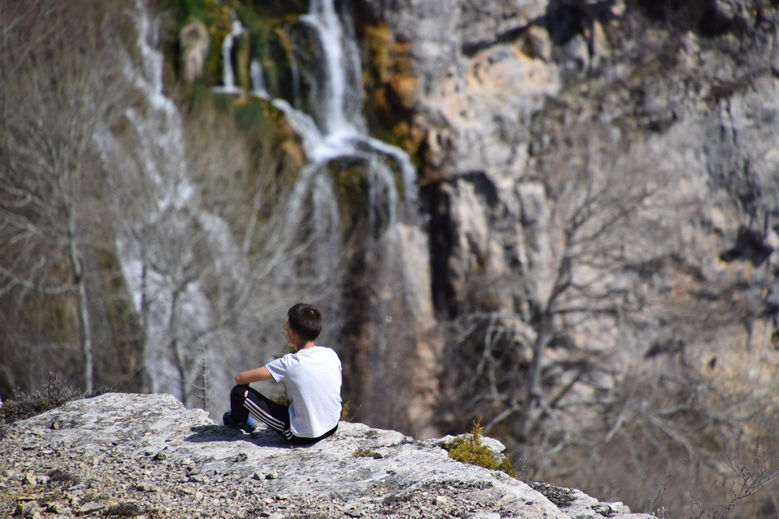
Day 1: Tarancón & Ucles
The following account will make an attempt at recording how much time was spent where (as recorded by our GPS device), as an exercise in time-tracking during holiday, since it is a common theme that time looks like it's flying by.
We took the van at 10h30. We spent 1h30 in a nearby supermarket (Rivas-Vaciamadrid) to get our stock of provisions for the trip and another 1h30 a few minutes later in the nearby parking of the Parque Regional del Sudeste for a first coffee. There, we had to dry the cooker which the silly woman had inundated. We knew this place from our visit of the meeting point of the Manzanares and Jarama, so we only had a look at the derelict building nearby (it was not possible to approach the river, which was fenced). So we resumed to reach our first important destination, Tarancón, where we stayed for about 1h20, mainly walking around and visiting the church (under the guidance of a local). Our next stop was Uclés. A portion of the road to get there was more difficult, but it was worth it as Uclés was the highlight of this first day. We stayed 1h40 there and another 25 minutes in a nearby mirador of the city, where we captured excellent shots with the sunset.
Tarancón
Tarancón in itself is not a very scenic place. Its name is famous nowadays as it is situated on a major road transit. In fact, at the meeting point of four provinces, it has always been famous even in times of no highways. It is also the 2nd city in the Provincia de Cuenca, and it still is of Celtiberic origin, so it is ultimately an everybody's destination. The most interesting part is El Castillejo, the oldest area of the town, and the church of Nuestra Señora de la Asunción, which hosts a significant reredos. As the city was under the preparation of the Semana Santa, we crossed an interesting spot under construction, namely, the hanging tree of Judas, which was a sophisticated setup where an actor would actually give the illusion of hanging himself (as explained to us by the workers setting it up). At this occasion, we realized that Antoine had very little knowledge of the Passion, and the reredos was a first opportunity to give more details (as was its purpose), but this seemed to interest Julia more. Our strolls beyond the Castillejo convinced us that it was no use spending more time there.
Uclés
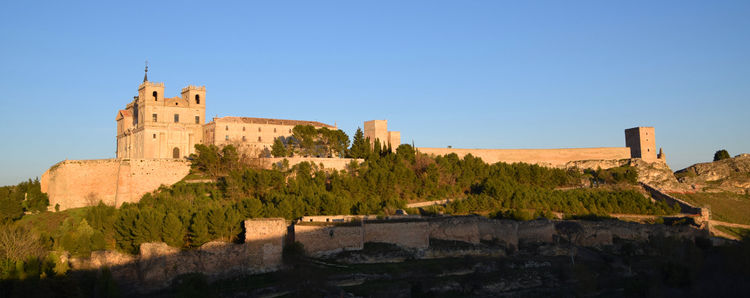
Uclés is a major highlight of Spain as a whole, for the magnificent complex that consists of the monastery and the surrounding castles, of various cultures and times. Important in Moorish times (Uqlīsh), it raised prominently at the Reconquista when it became the seat of the Order of Santiago. It also was the site of a Napoleonic war. Furthermore, the place is well isolated, since the road that leads to it is narrow and not well paved, so it remains immune to disruptive tourism (souvenir shops and the like). It was a pleasure and a moving experience to walk around the gigantic monastery, seemingly out of place in this desolated place. Sadly, we couldn't visit it inside as it was overtime; nevertheless, some private event was apparently taking place there. Nearing to sunset, swallows were dancing and spiralling on the Eastern side, which was a precious spectacle. Our itinerary
Green in Uclés, cyan by car on Fabrice by foot on the mountain at the mirador.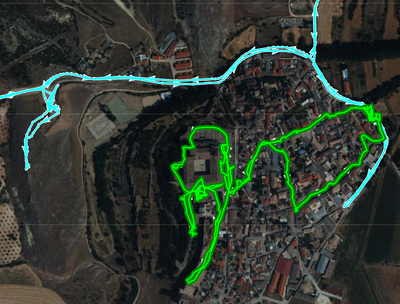 was naturally focused on the monastery and castle, but we crossed a procession, actually the only one, that consisted of children carrying a little altar, and pausing regularly to read religious texts. We accompanied them for a time, and then departed for the mirador, which confirmed the majestuous aspect of the whole ensemble.
was naturally focused on the monastery and castle, but we crossed a procession, actually the only one, that consisted of children carrying a little altar, and pausing regularly to read religious texts. We accompanied them for a time, and then departed for the mirador, which confirmed the majestuous aspect of the whole ensemble.
Day 2: Ventano del Diablo, Callejones de Las Majadas, Mirador del Tío Cogote, Huelamo and Tragacete, Nacimiento del rio Cuervo
The second day was probably the most intense one. We spent half an hour at the Ventano del Diablo, then three hours at the Callejones de las Majadas (12:00-15:00) and one hour at the nearby Mirador del Tio Cogote. We initially thought of spending the night in the area, maybe going back to the Callejones, but as this was going backward (even though a short ride), we decided to push our luck forward and carried on till the Embalse de la Toba (20min) and a longer pause in El Huelamo (50min), visiting in particular the ruins of its castle that dominates the local scenery, as well as the Jùcar, where Fabrice and Julia bathed (1h10min). We refilled everything at Tragacete and visited the place (40min). We parked in the woods of the Nacimiento del Rio Cuervo, which we planned to visit on the next morning, but there was enough light for us to go and meet the River at its very first moments. What a day!
Ventano del Diablo, Callejones de Las Majadas, Mirador del Tío Cogote
One of the most famous landmarks of the Cuenca region is the Ciudad Encantada, that consists of peculiar rock formations. This was on our list to visit, but we also knew of a similar place, the Callejones de Las Majadas, that is much less visited and possibly, equally or even more interesting, so we headed to this point first, with the Ventano del Diablo as a first stop; in fact, we went there the day before in the hope of spending the night but this was prohibited so we had to retreat to a parking (in Villalba de la Sierra, by the Jucar). The Ventano del Diablo is a beautiful mirador, naturally carved in the mountain and overlooking an impressive canyon formed by the Jucar. It is, however, a bit busy with tourism, although we could find ourselves alone for a few minutes, buses were dispatching waves of people. It was actually much quieter not in the Ventano itself, but climbing the mountain (a short climb). We quickly moved towards our next destination, the famous Majadas (itself a village, but we did not stop there).The Callejones de Las Majadas is another top-landmark of Spain as a whole (unless the Ciudad Encantada turns out to be significantly superior for some reason). It was indeed very quiet, and we basically had the place to ourselves. It is also very big. The map on the left shows the extent of the site, and in Green the part that we walked through (in red, by car). We covered about one-fourth of it. It is a magic place, with surreal surroundings (let alone the stones, but also wild horses passing by). A fun part is that you can walk on the rocks themselves, overlooking the maze from above, or through the many galleries. We initially planned to spend the night there, even maybe walk through by the light of the torch. There was another nearby landmark that we wanted to see in the meantime, however, El Mirador del Tío Cogote also known as Los Miradores de Las Majadas, and this was easier to go by car as it'd be a few hour walk otherwise. The mirador is an even more impressive view of the work of the Jucar, drawing through the mountains, than the Ventano del Diablo. There, the mountain is furthermore embraced by the woods, making it a stupendous view. You can walk along the rim. We walked quite a distance with Georges, and could have carried on forever, since each new angle was making it more gorgeous than the last, but we had left the girls behind and promptly returned. By then, since things were only getting more and more beautiful, we thought it vain to return to the Majadas, beside the roads in the Sierra are small, inconvenient and going backwards was unanimously felt a weaker move. So pushed forward, drove through one of the prettiest landscape we have met, reached the embalse de la Toba, with pretty turquoise waters trapped in the yellow mountains.
Huelamo and Tragacete

Carrying on the road, towards the Nacimiento del Río Cuervo, we spotted a breathtaking village, like a perched Andalusian white-city, but with a much smaller but also much steeper mountain than one is used to, making for a very ood and intoxicating feeling. We of course decided to deviate our course to go there. This was Huelamo. Even the ascension by car was already a sensation. We found where to park in a narrow spot at the entry of the village and proceeded, first towards the top of the rock itself, tracing a dizzying route through the village
In red by car, green by foot. On the left is visible the spot where we bathed.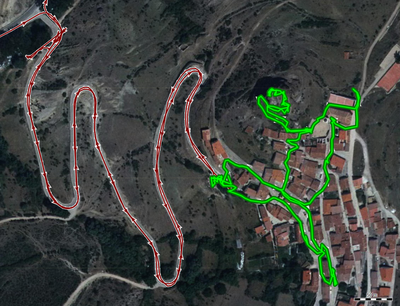 On our way back, in fact right at the foot of Huelamo, at a point where the Jucar was neither too small (we were going towards it birth-place) nor too big (trapped at the bottom of a canyon), we took a bath. Only Fabrice and Julia got the nerves to get in admittedly very cold waters. The feet for Julia, while Fabrice went integral (maybe this was a mistake as he got sick a few days later, maybe unrelatedly). Another stop on the way was Tragacete, shown above. The place had little to show in comparison, but we turned out to go and return there often, for its petrol station. The van was complaining of insufficient air-pressure in the wheels so we had to go there on the next day after a first visit to refuel. It became sort of our familiar spot of the area.
On our way back, in fact right at the foot of Huelamo, at a point where the Jucar was neither too small (we were going towards it birth-place) nor too big (trapped at the bottom of a canyon), we took a bath. Only Fabrice and Julia got the nerves to get in admittedly very cold waters. The feet for Julia, while Fabrice went integral (maybe this was a mistake as he got sick a few days later, maybe unrelatedly). Another stop on the way was Tragacete, shown above. The place had little to show in comparison, but we turned out to go and return there often, for its petrol station. The van was complaining of insufficient air-pressure in the wheels so we had to go there on the next day after a first visit to refuel. It became sort of our familiar spot of the area.
Bathing in the Jucar before leaving Huelamo.
Nacimiento del río Cuervo
This was to be the first time we would meet with the birth-place of a river (we missed that of the Manzanares at the Bola del Mundo!) This trip turned out to make us meet with three such places! There was no closing time so we could complete this expedition on the day. It was, besides, fairly easy as the path is neatly traced out in the woods. Also, there was literally nobody. The whole area was desert. Only us, and cascades, and more cascades, and the beginning of the river, that seemed to be waiting for us. It was a stupendous walk, with varying views, all of stupendous beauty. The birth-place itself is a hole in a mountain, where the water flows profusely. It's where it starts because it's where you stop. Who knows how it further carries on in the secrets of the Earth.
Day 3: Nacimiento del Rio Jùcar, Cascada del Molino de la Chorrera, Nacimiento del Tajo, Cañon de los Arcos
We spent 2h50 chasing the nacimiento del rio Jùcar, and another 2h40 exploring the Cascada del Molino de la Chorrera from various viewpoints (above, side, below). Then half an hour at the Nacimiento del Tajo (which we stumbled upon on our way). The highlight was the Cañon de los Arcos, to which we devoted 2 hours.
Nacimiento del Rio Jùcar
Cascada del Molino de la Chorrera

A bit downstream, when the cascade turned back into the Jucar.
Nacimiento del Tajo
The river Tagus (Tajo) is the longest river in Spain and we stumbled upon its birth-place by chance, our attention being attracted from the road by the Monumento al nacimiento del río Tajo, that honours the location of this important natural wonder. The monument itself is from the sculptor José Gonzalvo Vives whose recognizable work we met on several occasions during our trip. The sculpture, that brings together various iron sheets, is a tribute to the three provinces that surround the location: Guadalajara (with a knight), Cuenca (with a Calice) and Teruel (with a bull). The Tajo itself is personified by a gigantic masculine figure, Padre Jajo, crowned with a snowflake in reference to the source of the river and holding a spade in reference to the Roman origin of its name. One of the most interesting aspects of the monument is the sculpture Piel del Toro, which represents the Iberian Peninsula appropriately and cleverly carved in the shape of a bull. A line crosses it, from the birth-place to Lisboa, which is of course the Tagus itself. The weather was stormy and it even rained intermittently for the short duration that we walked around. The temptation was great to get walking along till Lisboa, but we carried on our route instead.
The Tajo a few meters after its birth. It's already fairly big!
Cañon de los Arcos
Day 4: Albarracín and Teruel
We spent 3h20 walking Albarracín up and down and 4h15 in Teruel. More time in this less interesting place, as we spent time at some nearby attractions and to buy shoes for Antoine. The rest of the days was spent trying to buy something in the outskirts of Teruel to recharge the battery in the campervan (vain attempt), or recharge it in a gas station (where we also refilled the water and disposed of the used one). We then drove to our next destination to spend the night there, at the foot of the castle of Mora de Rubielos.
Albarracín
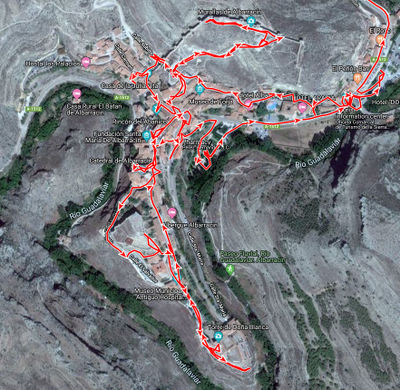
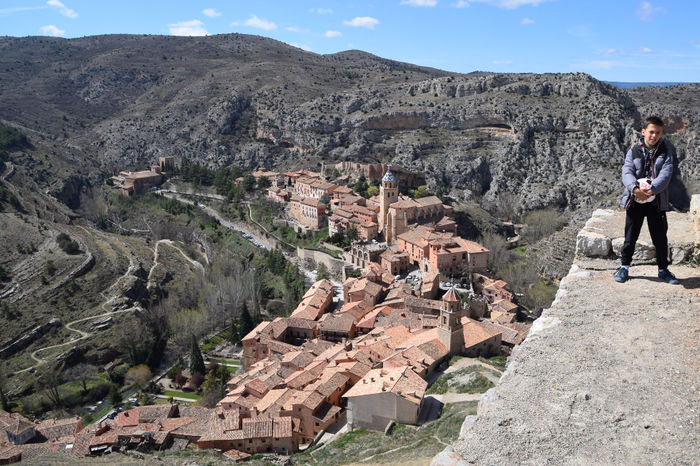
One was not supposed to go there, let alone with a football ball, but Antoine who preceded us, not reading Spanish, went anyway.
Teruel
Day 5: Mora de Rubielos & Rubielos de Mora, la Iglesuela del Cid, Canjavieja, Mirambel, Morella and Vallivana
2h25 in Mora de Rubielos and 1h55 in Rubielos de Mora, then in other notable villages on our way: 34min in la Iglesuela del Cid, 1h25 in Cantavieja, 1h15 in Mirambel, 1h in Morella and 1h20 in Vallivana.
Mora de Rubielos
(not to be confused with Rubielos de Mora)
Rubielos de Mora
(not to be confused with Mora de Rubielos)
la Iglesuela del Cid, Cantavieja, Mirambel
Morella and Vallivana
Day 6: Delta del Ebro
Day 7: Peñíscola, Playas
2h in Peñíscola, 3h50 in restaurant and playas
Peñíscola

Playas
Day 8: Sagunto, Requena
2h in Sagunto, 4h10 in Requena
Sagunto
